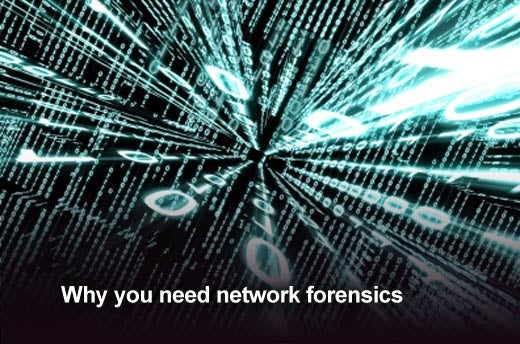Network forensics is the process of capturing, storing and analyzing activity that takes place on a computer network. While it’s often associated with solving network security breaches, the practice can also help solve far more common network issues, like spikes in utilization, drops in VoIP call quality, identifying rogue activity, and improving both network and application performance.
In this slideshow, WildPackets, provider of network and application performance analysis solutions, explains the basics of network forensics and how it can be used to improve network performance at all organizations.
Click through for the basics of network forensics and how it can be used to improve network performance at any organization, as identified by WildPackets.
What is network forensics?
Network forensics is the practice of recording and analyzing activity taking place on a network. Applying powerful search and analysis tools to recordings of network traffic, network forensics enables IT organizations to find the root causes of network performance and application delivery issues with accuracy and precision.
All organizations can benefit from network forensics
Forensics can play an important role in protecting networks from subtle and malicious security threats. Network forensics can enable an organization to adequately investigate and stop data breaches that threaten to cost organizations money, competitive advantage, or both. Collecting a complete record of network activity can be invaluable for addressing a host of technical, operational and organizational issues.
Why you need network forensics
Traditionally, organizations invested in network forensics when they recognized the need for a systematic approach to more quickly resolve security and network performance issues. That’s still true, but in the age of 10G and faster networks, forensics has taken on new and even greater importance as the only way organizations can conduct detailed analysis of the traffic crossing their network at 5Gbps or higher. Today’s networks transmit so much data that the only way to monitor and troubleshoot the traffic is to record it first. So, while network forensics is still an invaluable tool for finding proof of security attacks, it’s also now a “must-have” tool for thoroughly analyzing modern networks.
When you should apply network forensics
Forensics can be applied to many situations to solve performance, security and policy problems on today’s high-speed networks. These include:
- Finding proof of a security attack
- Troubleshooting intermittent performance issues
- Monitoring user activity for compliance with IT and HR policies
- Identifying the source of data leaks
- Monitoring business transactions
- Troubleshooting VoIP and video over IP
What you need to implement network forensics
Three essential capabilities are required to properly facilitate network forensics:
- Data Capture and Recording: The ability to capture and store multiple terabytes of data from high-throughput networks, including 10G and even 40G, without dropping or missing any packets.
- Data Discovery: Once data are recorded on the storage media, the solution should provide a means of filtering particular items of interest, for example, by IP address, application, context, etc. IT engineers rely on discovery tools for sifting through terabytes of data to find specific network conversations or individual packets in a timely fashion.
- Data Analysis: Automated analysis, including expert analysis that explains the context of network events, helps IT engineers quickly identify anomalous or otherwise significant network events. Once these are identified, they can go in and make the appropriate fix.








